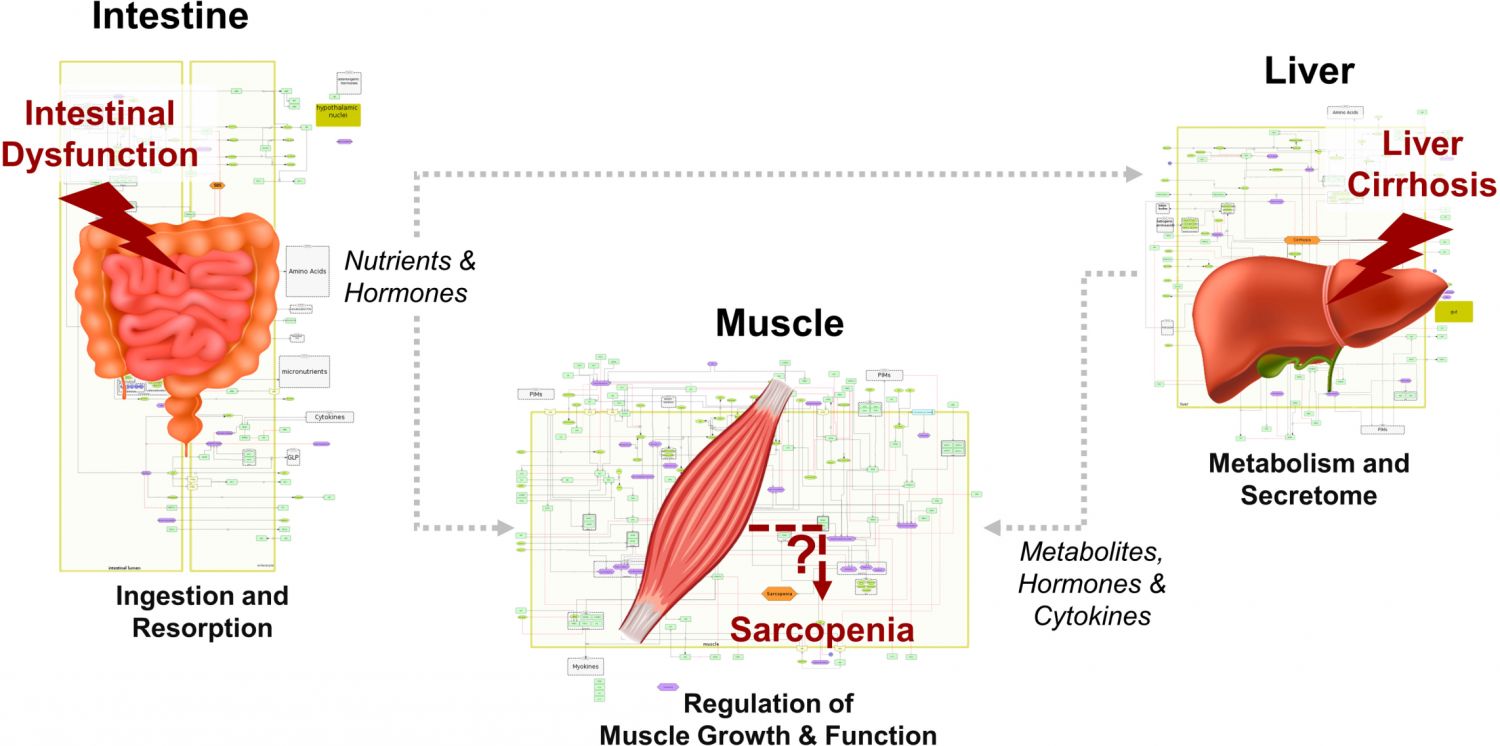
SBI – Department of Systems Biology and Bioinformatics
Faculty of Computer Science and Electrical Engineering
University of Rostock
Ulmenstrasse 69 | 18057 Rostock
Germany
+49 381 498-7571
olaf.wolkenhauer@uni-rostock.de

Sarcopenia Map
In collaboration with the Division of Gastroenterology at the Rostock University Medical Center (as part of the EnErGie project) we are developing an in-depth, standardized, and computationally encoded disease map of the molecular interactions regulating muscle growth and function. We integrated the two disease states intestinal dysfunctions (ID) and liver cirrhosis (LC) into the map to investigate their contribution to the loss of muscle function (sarcopenia).
Malnutrition (MN) is a common and characteristic feature of gastrointestinal diseases, such as ID and LC, and is connected to high mortality rates. For LC patients, the prevalence of MN is indicated with up to 90%; for patients suffering from short bowel syndrome (SBS) with around 10 to 40%. Disease-related MN is closely related to mild, chronic inflammation. Both MN and inflammation contribute to muscle wasting, which, combined with sarcopenia, can negatively influence gastrointestinal diseases. Therefore, sarcopenia is a common secondary phenomenon in LC and ID. The vicious cycle of MN, inflammation, sarcopenia and the underlying disease itself leads to an unfavorable prognosis for the patient. The molecular landscape of gastrointestinal disease, nutrition, and muscle metabolism each involves hundreds to thousands of molecules and proteins that form complex molecular communication networks. Linking these processes again increases the complexity many times over. Although the role of many molecules has been elucidated by extensive in vitro and in vivo experiments, understanding the system as a whole, including all the interactions involved, is a task beyond human capabilities. Therefore, the use of in silico approaches, i.e., the conversion of available knowledge into computationally readable formats, can help unravel its complex structure.
We modularized the map into tissue-specific sub-maps for i) the intestine, i.e., nutrient uptake, its hormonal regulation, and the effects of ID, ii) the liver, i.e., metabolic processes, cytokine secretion, and their alteration in LC, iii) and the muscle, i.e., molecular regulation of catabolic and anabolic muscular processes leading to sarcopenia. In addition, we converted the underlying interaction network into a Boolean model and validated the model by investigating how molecular perturbations are perpetuated in the model. We integrated our methods into an interactive MINERVA tool suite allowing researchers to explore the information on the maps, identify interaction pathways, and perform in silico perturbation experiments. With these tools, we demonstrate how the map contributes to understanding the complex molecular processes leading to sarcopenia. The Sarcopenia Map is publicly available as an open-source, interactive online resource, providing tools that allow users to explore the information on the map and perform in silico perturbation experiments.

Related publications
In silico investigation of molecular networks linking gastrointestinal diseases, malnutrition, and sarcopenia
Hoch M, Ehlers L, Bannert K, Stanke C, Brauer C, Caton V, Lamprecht G, Wolkenhauer O, Jaster R, Wolfien M
Frontiers in Nutrition (2022)